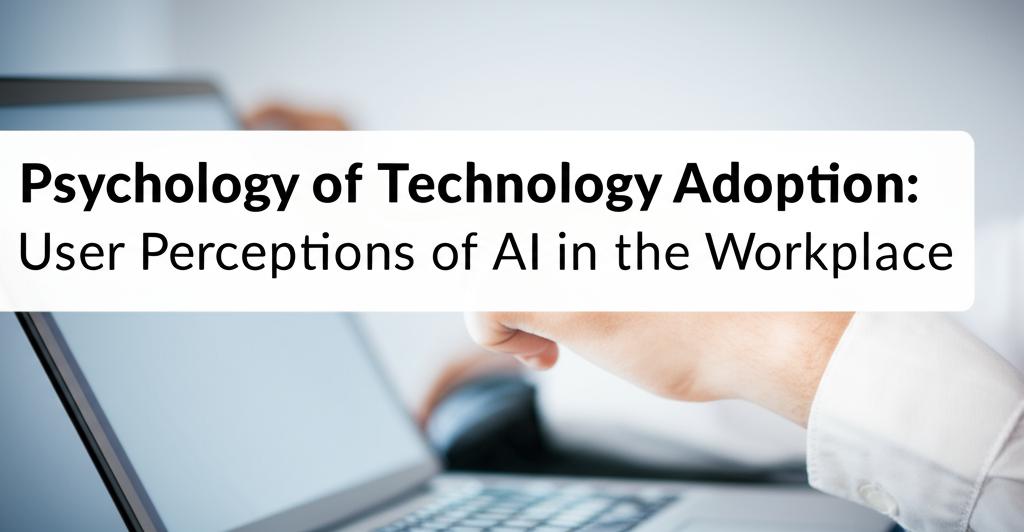The integration of Artificial Intelligence (AI) into the workplace is rapidly transforming how businesses operate and how employees experience their work. Understanding the psychological factors that drive user perceptions and adoption of AI is crucial for organizations aiming to leverage this technology effectively.
Current State of AI Adoption and Employee Perceptions:Recent studies indicate a growing adoption of AI in the workplace. In 2024, three-quarters of surveyed workers reported using AI, with nearly half of them starting in the preceding six months. A significant majority of companies (75%) expressed intentions to adapt to AI within the next five years as of 2023. This trend is driven by the belief that AI is essential for staying competitive, with 79% of company leaders acknowledging this necessity.
However, this increasing adoption is met with a complex mix of employee emotions and attitudes. While many employees are optimistic about AI, with some reports indicating that a majority describe themselves as "AI optimists," concerns and anxieties also prevail. A notable 45% of workers in 2024 expressed worries about AI replacing them in their jobs.
Key Psychological Factors Influencing AI Adoption:Several psychological elements play a critical role in how employees perceive and adopt AI:
- Trust: Trust is a cornerstone of AI adoption. Research shows a significant gap between AI usage and user trust. While 66% of people globally use AI regularly, only 46% are willing to trust AI systems. In the workplace, concerns about AI reliability, "hallucinations" (AI generating false information), data privacy, and security are major barriers to trust. Organizations that successfully build trust in AI see increased user engagement and perceived output quality.
- Emotional Reactions: Employees' emotional responses to AI significantly impact their willingness to adopt it. Positive emotions, such as a sense of achievement and perceiving AI as a challenge that offers growth opportunities, tend to foster adoption. Conversely, negative emotions like AI anxiety, fear of job displacement, and a perceived lack of control can lead to resistance and withdrawal.
- Perceived Usefulness and Ease of Use (Performance and Effort Expectancy): Classic technology adoption models highlight that individuals are more likely to adopt a technology if they believe it will help them perform their job better (performance expectancy) and if they find it easy to use (effort expectancy). If AI tools are perceived as too complex or not directly beneficial to an employee's tasks, adoption will likely be slower.
- Technostress: AI-driven technostress can be categorized into "challenge stressors" (perceived as opportunities for growth) and "hindrance stressors" (seen as obstacles). Challenge stressors can trigger positive emotions and increase AI adoption intention, while hindrance stressors often lead to AI anxiety and reduced willingness to adopt.
- Fear of the Unknown and Loss of Control: The complexity of AI can be intimidating. Many users have little understanding of how AI algorithms work, leading to a "black box" perception that breeds distrust and fear. Additionally, the idea that AI will take over decision-making and reduce human autonomy is a common concern.
- Self-Efficacy: An employee's belief in their own ability to learn and use new technologies (technical self-efficacy) plays a moderating role. Higher self-efficacy can amplify the positive effects of challenge stressors and diminish the negative impact of hindrance stressors on AI adoption.
- Job Security Concerns: The fear of AI leading to job displacement is a significant psychological barrier. While some studies suggest AI will create new job opportunities, with 61% of employees believing it will lead to new career pathways, the anxiety about being replaced remains a prominent factor.
- Ethical Concerns: Issues such as bias in AI algorithms, lack of accountability for AI-driven decisions, and data privacy violations can exacerbate resistance to AI adoption.
Organizations can implement several strategies to address these psychological factors and encourage positive AI adoption:
- Invest in Training and Skills Development: Employees express a strong desire for more formal training to successfully navigate AI. Providing comprehensive training, hands-on sessions, and mentorship programs can demystify AI, enhance technical self-efficacy, and improve performance and effort expectancy.
- Promote Transparency and Communication: Clear communication about how AI systems work, their benefits, limitations, and the organization's vision for AI integration is crucial. Addressing concerns about data privacy and security openly can help build trust.
- Build Trust Proactively: Organizations should prioritize building trust from the outset of AI implementation. This includes establishing clear governance frameworks for AI use, ensuring reliability, and addressing ethical considerations.
- Emphasize Collaboration (Human-in-the-Loop): Position AI as a tool that augments human capabilities rather than replacing them. Highlighting how AI can handle repetitive tasks, allowing employees to focus on more strategic and creative work, can alleviate fears of job loss and loss of control.
- Foster a Supportive Organizational Culture: Leadership plays a key role. Managerial capability and organizational support can significantly influence employee well-being during AI adoption. Creating a culture where employees feel supported in learning and adapting to new technologies is essential.
- Address Emotional Well-being: Recognize and address the emotional impact of AI. This can include providing resources for managing AI-related stress and anxiety, and fostering an environment where employees feel comfortable expressing their concerns.
- Involve Employees in AI Implementation: Giving employees opportunities to participate in the development and rollout of AI tools, such as beta testing and providing feedback, can increase their sense of ownership and acceptance.
- Provide Incentives and Recognition: Financial rewards and recognition for adopting and effectively using AI tools can also improve uptake.
Employees are generally ready to embrace AI, often more so than leaders might imagine. They are familiarizing themselves with AI tools and see the potential for AI to impact their work significantly. The onus is now on organizational leaders to step up, provide the necessary support and training, and create an environment where AI can be adopted effectively and ethically. Addressing the psychological dimensions of AI adoption is not just a secondary concern but a primary driver of successful AI integration and achieving its full potential in the workplace.

